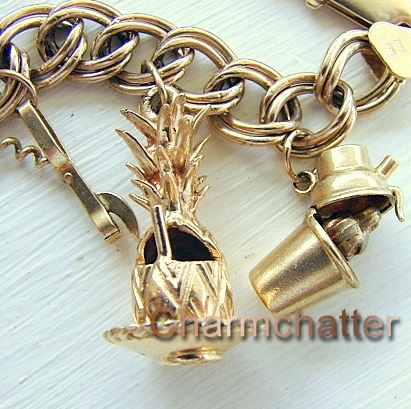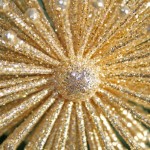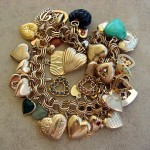What Type Of Gold Jewelry Should You Buy?
I’ve written about gold before in my Gold Fun Facts page, but gold jewelry has been on my mind lately so I’ve decided to revisit the subject in a more serious fashion. The price of gold jewelry has gone above my jewelry purchasing comfort zone and I’m trying to get a handle on what alternatives are available. So I’ve done a little research on the different types of gold used for jewelry and made a list of some definitions and features. Once I got started I realized there are more types of gold jewelry than I thought. So I’ve decided to share my findings and perhaps it will help one of my readers in their gold jewelry selections. My list is in order of my interpretation of which is best to not-so-good – others may think differently.
Karat Gold
Not to be confused with “carat”. Carat with a C describes the size of a gemstone. Karat with a K represents the amount of pure gold in a piece.
Karat gold marks range anywhere from 8K to 24K. Most governments regulate the marks on gold jewelry so you know what degree of gold you have (within an acceptable variance). 24K is pure gold. Pure gold is rarely used for jewelry because it’s too soft. The smaller the number the less gold is in the item. You can divide the number on your jewelry by 24 to get the %. For example 14K gold is 58.3% gold or 14/24. The other 41.7% is a metal alloy which typically makes the metal harder and determines the color of the gold.
In the United States anything below 10K can’t be labeled as gold jewelry. In Europe you will see a lot of 9K jewelry pieces so I assume the rules are different there. One advantage to Karat gold jewelry is that it holds its value, and sometimes increases in value.
Karat gold is available in several colors. Yellow is the most popular. Yellow gold is a mixture of gold with copper and zinc. White gold usually contains silver and palladium, rose gold is mixed with copper, and so forth. White gold actually is a gray color in its original form and is plated with rhodium to achieve the shiny sparkly finish. Other less common colors are black and green.
Plumb Gold
Once in a while you will find a piece of jewelry with KP instead of just the K. That means the purity is exactly as stated with no variance. Most of the time this mark is used on gold bullion or gold used in science and industry.
Gold Filled
Gold filled jewelry is made from a thin layer of gold that’s heat fused onto a base metal. It’s like a tube of gold filled with another metal, often brass or copper. It’s used in high quality jewelry and typically will last for many years. It is considered lifetime jewelry and the best form of gold plating. In jewelry from the early 1900s it may be described as “gilt”. The government standard is that at least 5% of the metal weight must be 10K gold or higher. The most common mark is 1/20 GF or 12 K Gold Filled. This means it is at least 1/20th 12K gold by weight.
Rolled Gold
Rolled gold is the same as gold filled except the legal standard is lower. An example or a rolled gold marking is 1/40 18K RG. This means that an 18K layer has been fused to a base metal and 1/40 of the total weight of the piece is 18k gold.
Black Hills Gold
Black Hills gold is a type of rolled gold jewelry made in the Black Hills of South Dakota. It was created in the 1870s and typically has leaves, vines and grape clusters in the design. It’s made from a combination of green, rose, and yellow gold, often 10 karat. Silver is alloyed with the yellow gold to produce the green hue, and copper is used to make the red or pink gold. Although the jewelry must be made in South Dakota to be called Black Hills gold, the actual gold can come from anywhere.
Gold Vermeil
Gold Vermeil jewelry is actually sterling silver with a thin layer of gold plating. The plating must be at least 10K and be 2.5 micrometers thick. It’s usually more expensive than gold plate because the base metal is sterling silver and the plating is thicker. It’s pronounced gold “vehr may”.
Gold Plate
Gold plated jewelry consists of a base metal, typically silver, steel, or brass, which is dipped into an electroplating solution that leaves a thin layer of gold on the exterior. The gold layer is a lower percentage gold than gold filled and can scratch or wear off with time. Gold plate is commonly used in high end costume jewelry. You will find often find the terms electroplate used to describe this type of jewelry. The markings can be HGEP or HGP which means “Hard Gold Electroplate”.
Gold Wash
Gold wash uses a very minimum of gold – there is no legal standard. It’s an ultra-thin electroplate and isn’t marked. Gold wash is usually found on very cheap costume jewelry.
Caring for Gold Jewelry
It’s very easy to take care of gold jewelry. You just need to wash it with soapy water and dry it with a soft cloth. Then polish with a jewelry polishing cloth. Gold will have a chemical reaction to chlorine so be careful not to swim with your jewelry on.

More from my site
Category: Facts & Useful Info









